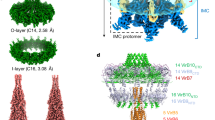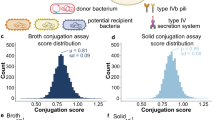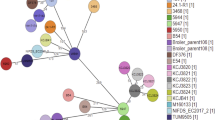Abstract
THE process of formation of conjugal pairs is an intriguing aspect of the conjugation system of Escherichia coli. The process involves an interaction of surface components, especially F-pili1. There is also evidence that implicates further surface components2–4. Several attempts to obtain visual evidence for the nature of the conjugal bond have been reported, including the early use5 of negative staining techniques to study conjugation, and later studies with thin sectioning to obtain ultrastructural evidence6,7. These studies have demonstrated simple associations in pair formation in which the walls have merely been brought into close juxtaposition6, and also a more elaborate system in which bridging bubbles apparently arise from the outer cell wall layers of the recipient cells7. All these studies have used morphologically distinct donor and recipient cells to improve the recognition of possible conjugal pairs. Our purpose here is to report the observation, in cultures which consist solely of F− cells, of structures similar to those described above, and to suggest some of the limitations of electron microscopy for studies of this type.
This is a preview of subscription content, access via your institution
Access options
Subscribe to this journal
Receive 51 print issues and online access
$199.00 per year
only $3.90 per issue
Buy this article
- Purchase on SpringerLink
- Instant access to full article PDF
Prices may be subject to local taxes which are calculated during checkout
Similar content being viewed by others
References
Brinton, jun., C. C., in The Specificity of Cell Surfaces (edit. by Davis, B. D., and Warren, L.), 37 (Prentice-Hall, Inc., Englewood Cliffs, New Jersey, 1967).
Schwartz, G. H., Eiler, D., and Kern, M., J. Bacterial., 89, 89 (1965).
Lancaster, J. H., Goldschmidt, E. P., and Wyss, O., J. Bacterial., 89, 1478 (1965).
Curtiss, R., III, Caro, L. G., Allison, D. P., and Stallions, D. R., Bacterial., 100, 1091 (1969).
Anderson, T. F., Wollman, E. L., and Jacob, F., Ann. Inst. Pasteur, 93, 450 (1957).
Gross, J. D., and Caro, L. G., J. Mol. Biol., 16, 269 (1966).
Schreil, W. H., and Christensen, R. J., Proc. US Nat. Acad. Sci., 59, 1152 (1968).
Lancaster, J. H., and Skvarla, J. J., Stain Technol., 43, 265 (1968).
Author information
Authors and Affiliations
Rights and permissions
About this article
Cite this article
LANCASTER, J., SKVARLA, J. Ultrastructure Studies of Conjugating Escherichia coli. Nature 226, 556–557 (1970). https://doi.org/10.1038/226556a0
Received:
Issue date:
DOI: https://doi.org/10.1038/226556a0



